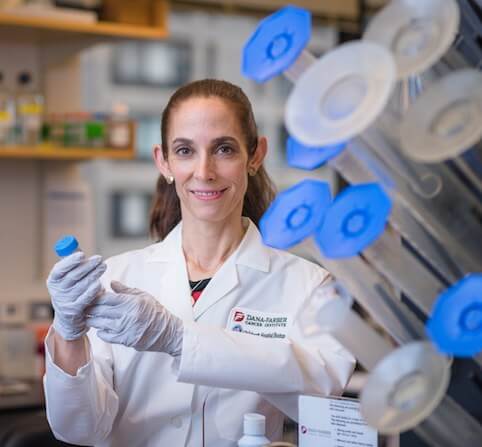Investigators led by Dana-Farber Cancer Institute’s Kimberly Stegmaier, MD, have discovered that knocking out a protein regulator in Ewing sarcoma cells causes the tumor cells to die from an overdose of a cancer-promoting protein. The regulator, a protein known as TRIM8, is critical to the survival of Ewing sarcoma cells because it controls the levels of EWS/FLI, a cancer protein or oncoprotein, which drives malignancy in the great majority of Ewing tumors.
Stegmaier, a pediatric oncologist, and lead investigator of the study in Cancer Cell, says TRIM8 is a “very, very exciting” potential target for drug therapy in Ewing sarcoma, a rare cancer found in the bone or soft tissue of teenagers and young adults.
Filling a void
TRIM8 is one of the many proteins in cells that help control the levels of expression of other proteins. TRIM8 is a type protein known as an E3 ligase, which marks proteins for disposal if no longer needed by the cell.
Currently there is no available drug to directly target the EWS/FLI transcription factor as treatment for Ewing sarcoma. Transcription factors are very difficult to directly target with drugs, because their physical structure is unstable, changing shape when they bind to DNA. Moreover, transcription factor proteins have very few accessible sites for a drug to bind to.

However, the authors of the new study show that targeting TRIM8, which regulates EWS/FLI levels, might be an indirect route to altering EWS/FLI activity in Ewing tumors. They demonstrate that TRIM8 is a highly selective dependency: when more than 700 different cancer cell lines were tested, only Ewing sarcoma cells were dependent on TRIM8. And when TRIM8 was knocked out or inhibited, EWS/FLI activity increased, causing cell death by oncogene overdose.
Stegmaier and her colleagues also used cutting-edge protein degradation techniques to eliminate TRIM8 in laboratory Ewing sarcoma cell lines. In doing so, they disrupted the control of the EWS/FLI oncoprotein leading to an overdose of the protein, which the sarcoma cells could not tolerate. Moving to laboratory animals, the scientists knocked out TRIM8 with CRISPR technology in Ewing sarcoma tumors growing in mice and it “dramatically impaired tumor progression,” says Stegmaier.
Not only is an excess of EWS/FLI toxic to the Ewing sarcoma cells, but the opposite is also true, the scientists found. They overexpressed TRIM8 in Ewing cells, which reduced EWS/FLI activity, and the deficiency of that oncoprotein was also deleterious to the cancer cells. Stegmaier calls this the “‘Goldilocks principle’ — that too little or too much oncoprotein is lethal and “just the right” level is required for cancer cell survival” — at least in this cancer driven by the fusion transcription factor EWS/FLI.
While the strategy of using the TRIM8 dependency to indirectly target EWS/FLI in Ewing sarcoma seems promising, Stegmaier notes that there are no existing drugs that can suppress TRIM8. But she says the findings of the study have increased enthusiasm in the pharmaceutical sector for TRIM8 as a potential target.
